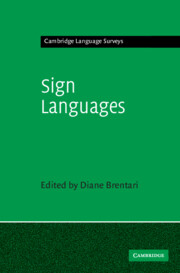Book contents
- Frontmatter
- Contents
- List of figures
- List of tables
- List of contributors
- List of sign language abbreviations
- Notational conventions
- 1 Introduction
- I HISTORY AND TRANSMISSION
- II SHARED CROSSLINGUISTIC CHARACTERISTICS
- III VARIATION AND CHANGE
- 18 Sign languages in West Africa
- 19 Sign languages in the Arab world
- 20 Variation in American Sign Language
- 21 Sociolinguistic variation in British, Australian and New Zealand Sign Languages
- 22 Variation in East Asian sign language structures
- 23 Crosslinguistic variation in prosodic cues
- 24 Deixis in an emerging sign language
- 25 The grammar of space in two new sign languages
- Notes
- References
- Index
21 - Sociolinguistic variation in British, Australian and New Zealand Sign Languages
from III - VARIATION AND CHANGE
Published online by Cambridge University Press: 05 June 2012
- Frontmatter
- Contents
- List of figures
- List of tables
- List of contributors
- List of sign language abbreviations
- Notational conventions
- 1 Introduction
- I HISTORY AND TRANSMISSION
- II SHARED CROSSLINGUISTIC CHARACTERISTICS
- III VARIATION AND CHANGE
- 18 Sign languages in West Africa
- 19 Sign languages in the Arab world
- 20 Variation in American Sign Language
- 21 Sociolinguistic variation in British, Australian and New Zealand Sign Languages
- 22 Variation in East Asian sign language structures
- 23 Crosslinguistic variation in prosodic cues
- 24 Deixis in an emerging sign language
- 25 The grammar of space in two new sign languages
- Notes
- References
- Index
Summary
In this chapter, we will examine the historical relationship between signed languages used in the United Kingdom (British Sign Language, or BSL), Australia (Australian Sign Language, or Auslan) and New Zealand (New Zealand Sign Language, or NZSL), as well as work on sociolinguistic variation and language change in all three sign language varieties. Following Johnston (2003), we will adopt the acronym BANZSL here (i.e., British, Australian and New Zealand Sign Language) to refer to all three signed languages as a group. We will begin by outlining the history of BSL and its transmission to the former British colonies of Australia and New Zealand, before discussing studies that have compared similarities in the lexicon of BSL, Auslan and NZSL. We will then explore the relationship between phonological, lexical and syntactic variation and change in these three related languages and social factors such as a signer's regional origin, age and gender.
The deaf communities in the UK, Australia and New Zealand
The prevalence of deafness in developed societies has long been estimated to be about 0.1 percent of the population (i.e., one in one thousand people) (Schein 1968, Schein & Delk 1974). If this were the case, one would expect the deaf communities of the UK, Australia and New Zealand to number 60,000, 20,000 and 4,000 individuals respectively, based on the national populations of each country. The precise number of signing deaf people in all three countries is, however, unknown.
- Type
- Chapter
- Information
- Sign Languages , pp. 476 - 498Publisher: Cambridge University PressPrint publication year: 2010
- 14
- Cited by



